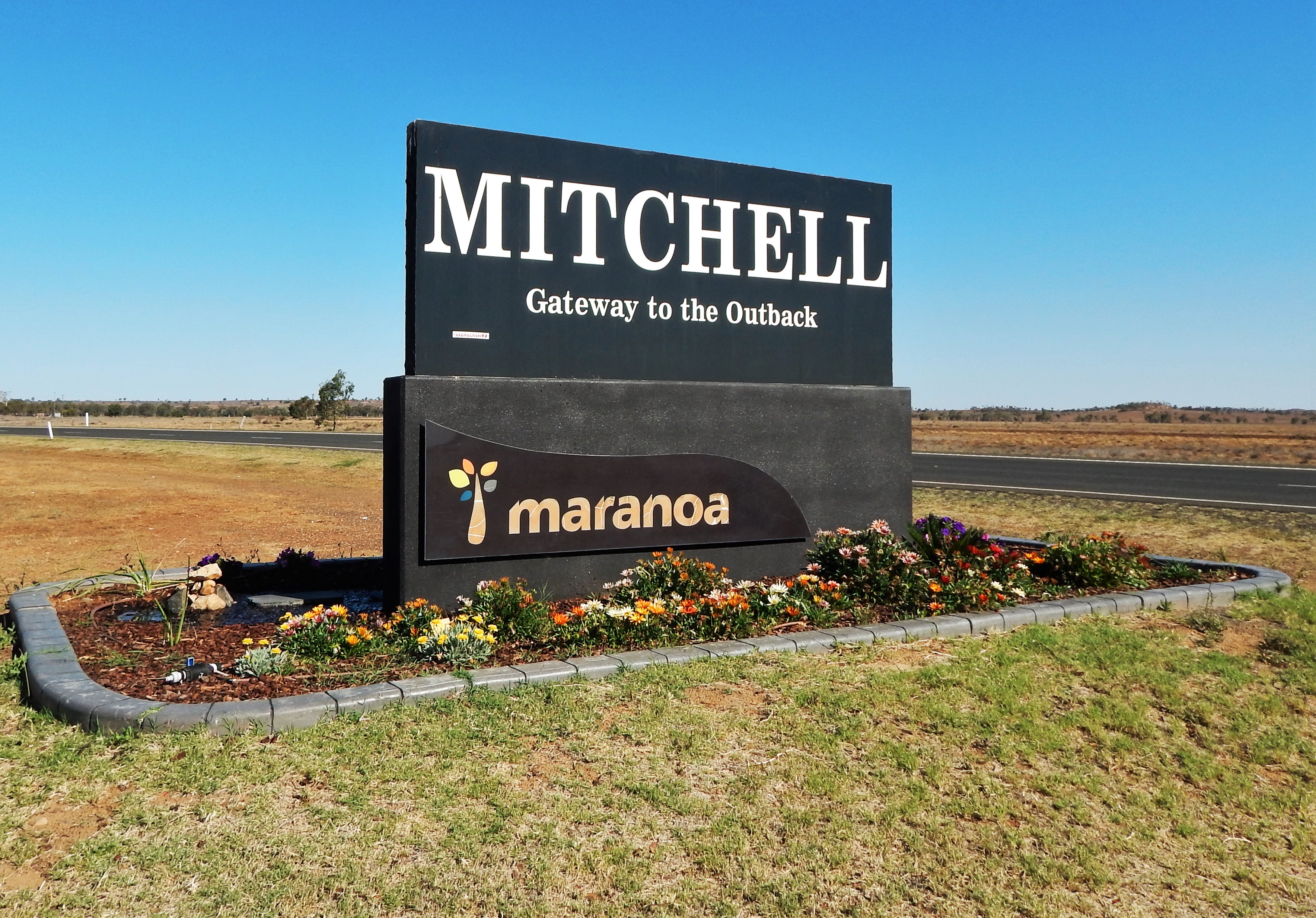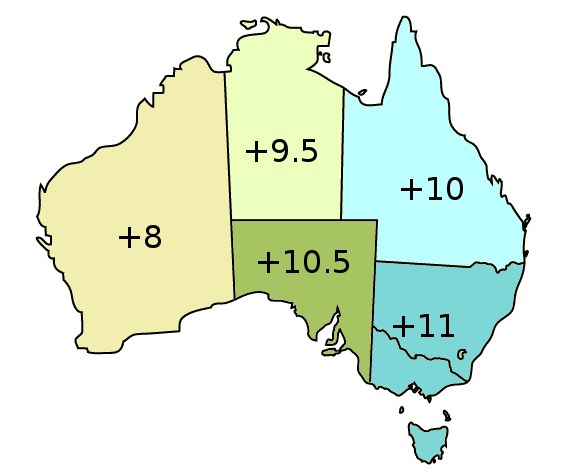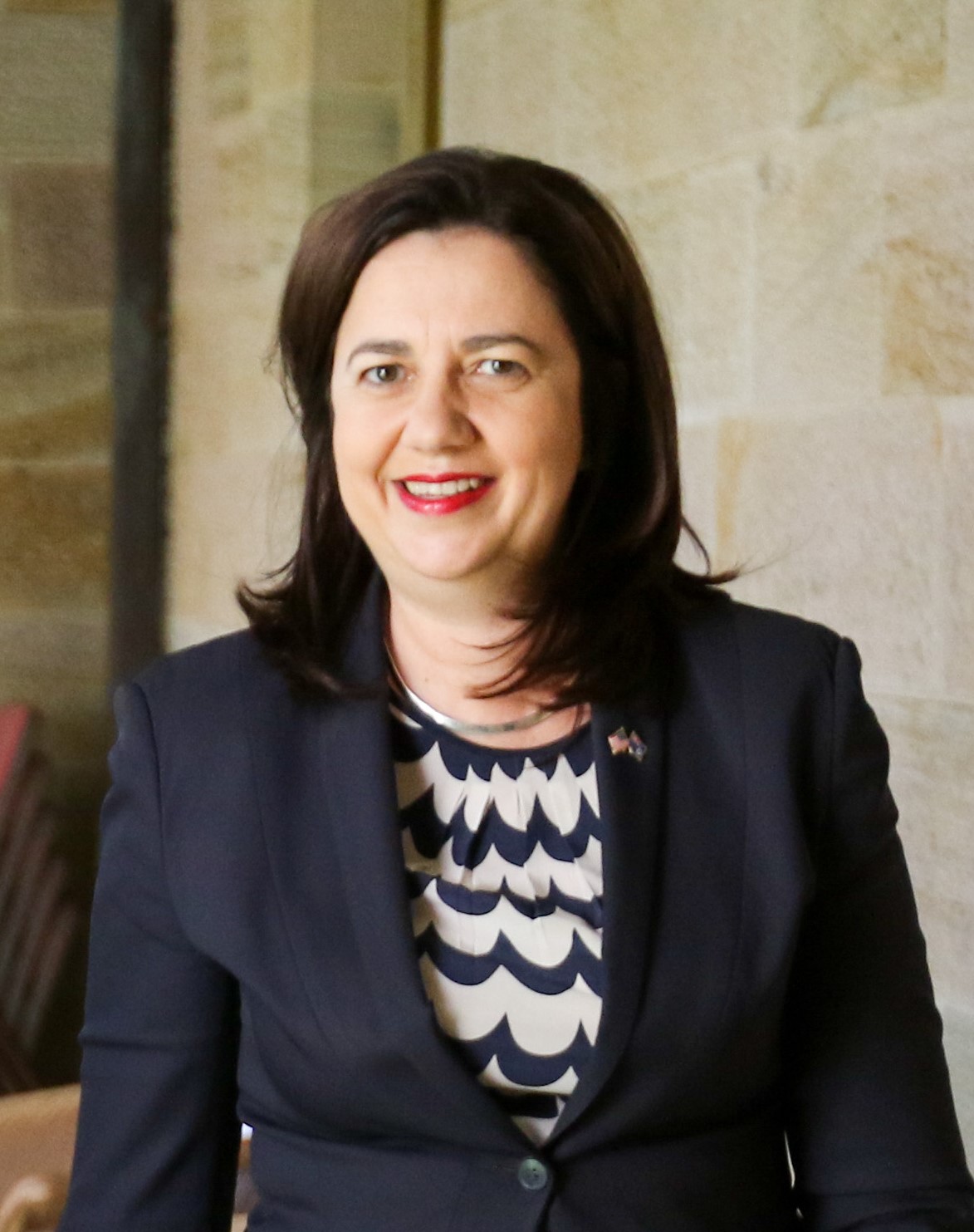|
Mitchell, Queensland
Mitchell is a rural town and locality in the Maranoa Region, Queensland, Australia. The town services the local area, a cattle and sheep farming district. In the , the locality of Mitchell had a population of 1,031 people. Geography Mitchell is on the Warrego Highway, west of Brisbane, 441 kilometres (274 mi) west of Toowoomba, 230 kilometres (143 mi) west of Miles, 89 kilometres (55 mi) west of Roma and 180 kilometres (112 mi) east of Charleville. The Warrego Highway passes through town to form the main street, Cambridge Street. The Maranoa River flows around the northern and eastern sides of the town before eventually flowing into the Balonne River. The Western railway passes through the locality, entering from the east ( Amby / Walhallow) and exiting to the west ( Womalilla). The locality is served by a number of railway stations, from west to east: * Mitchell railway station, a passenger stop in the town () * Booringa railway siding, now dismantled () * Marbango rai ... [...More Info...] [...Related Items...] OR: [Wikipedia] [Google] [Baidu] |
AEST
Australia uses three main time zones: Australian Western Standard Time (AWST; UTC+08:00), Australian Central Standard Time (ACST; UTC+09:30), and Australian Eastern Standard Time (AEST; UTC+10:00). Time is regulated by the individual state governments, some of which observe daylight saving time (DST). Australia's external territories observe different time zones. Standard time was introduced in the 1890s when all of the Australian colonies adopted it. Before the switch to standard time zones, each local city or town was free to determine its local time, called local mean time. Now, Western Australia uses Western Standard Time; South Australia and the Northern Territory use Central Standard Time; while New South Wales, Queensland, Tasmania, Victoria, Jervis Bay Territory, and the Australian Capital Territory use Eastern Standard Time. Daylight saving time (+1 hour) is used in jurisdictions in the south and south-east: South Australia, New South Wales, Victoria, Tasm ... [...More Info...] [...Related Items...] OR: [Wikipedia] [Google] [Baidu] |
Toowoomba
Toowoomba ( , nicknamed 'The Garden City' and 'T-Bar') is a city in the Toowoomba Region of the Darling Downs, Queensland, Australia. It is west of Queensland's capital city Brisbane by road. The urban population of Toowoomba as of the 2021 Census was 142,163, having grown at an average annual rate of 1.45% over the previous two decades. Toowoomba is the second-most-populous inland city in the country after the national capital of Canberra and hence the largest city on the Darling Downs, and it is among the largest regional centres in Queensland. It is also referred to as the capital of the Darling Downs. The Toowoomba region is the home of two main Aboriginal language groups, the Giabal whose lands extend south of the city and Jarowair whose lands extend north of the city. The Jarowair lands include the site of one of Australia's most important sacred Bora ceremonial ground, the ‘Gummingurru stone arrangement’ dated to c.4000 BC. The site marked one of the major rout ... [...More Info...] [...Related Items...] OR: [Wikipedia] [Google] [Baidu] |
Australian Aboriginal Language
The Indigenous languages of Australia number in the hundreds, the precise number being quite uncertain, although there is a range of estimates from a minimum of around 250 (using the technical definition of 'language' as non-mutually intelligible varieties) up to possibly 363. The Indigenous languages of Australia comprise numerous language families and isolates, perhaps as many as 13, spoken by the Indigenous peoples of mainland Australia and a few nearby islands. The relationships between the language families are not clear at present although there are proposals to link some into larger groupings. Despite this uncertainty, the Indigenous Australian languages are collectively covered by the technical term "Australian languages", or the "Australian family". The term can include both Tasmanian languages and the Western Torres Strait language, but the genetic relationship to the mainland Australian languages of the former is unknown, while the latter is Pama–Nyungan, tho ... [...More Info...] [...Related Items...] OR: [Wikipedia] [Google] [Baidu] |
Mandandanji Language
Bidjara, also spelt Bidyara or Pitjara, is an Australian Aboriginal language. In 1980, it was spoken by twenty elders in Queensland between the towns of Tambo and Augathella, or the Warrego and Langlo Rivers. There are many dialects of the language, including Gayiri and Gunggari. Some of them are being revitalised and is being taught in local schools in the region. Dialects The Bidjara language included numerous dialects, of which Bidjara proper was the last to go extinct. One of these was Gunya (Kunja), spoken over 31,200 km2 (12,188 sq mi), from the Warrego River near Cunnamulla north to Augathella and Burenda Station; west to between Cooladdi and Cheepie; east to Morven and Angellala Creek; at Charle-ville. Fred McKellar was the last known speaker. Yagalingu is poorly attested but may have been a dialect of Bidjara. Natalie Kwok prepared a report on Gunggari for the National Native Title Tribunal in Australia. In it she says: :Language served as an important ... [...More Info...] [...Related Items...] OR: [Wikipedia] [Google] [Baidu] |
Mount Moffatt
Mount Moffatt is a rural locality in the Maranoa Region, Queensland ) , nickname = Sunshine State , image_map = Queensland in Australia.svg , map_caption = Location of Queensland in Australia , subdivision_type = Country , subdivision_name = Australia , established_title = Before federation , established_ ..., Australia. In the , Mount Moffatt had a population of 0 people. Mount Moffatt's postcode is 4465. History The locality was initially called Mount Moffatt, but changed to Mount Moffatt on 18 October 2002. It is presumably named after the mountain Mount Moffatt () within the locality (). References {{Maranoa Region Maranoa Region Localities in Queensland ... [...More Info...] [...Related Items...] OR: [Wikipedia] [Google] [Baidu] |
1946 Centenary Memorial, Mitchell, Queensland
Events January * January 6 - The first general election ever in Vietnam is held. * January 7 – The Allies recognize the Austrian republic with its 1937 borders, and divide the country into four occupation zones. * January 10 ** The first meeting of the United Nations is held, at Methodist Central Hall Westminster in London. ** ''Project Diana'' bounces radar waves off the Moon, measuring the exact distance between the Earth and the Moon, and proves that communication is possible between Earth and outer space, effectively opening the Space Age. * January 11 - Enver Hoxha declares the People's Republic of Albania, with himself as prime minister. * January 16 – Charles de Gaulle resigns as head of the French provisional government. * January 17 - The United Nations Security Council holds its first session, at Church House, Westminster in London. * January 19 ** The Bell XS-1 is test flown for the first time (unpowered), with Bell's chief test pilot Jack Wool ... [...More Info...] [...Related Items...] OR: [Wikipedia] [Google] [Baidu] |
Maranoa Regional Council
Maranoa Region is a local government area in South West Queensland, Australia. The town of Roma is the administrative headquarters of the region. History The Gunggari language region of South West Queensland includes the landscape within the local government boundaries of the Maranoa Region particularly the towns of Mitchell, Amby, Dunkeld and Mungallala and the properties of Forest Vale and North Yanco. '' Gungabula'' (also known as ''Kongabula'' and ''Khungabula'') is an Australian Aboriginal language of the headwaters of the Dawson River in Central Queensland. The language region includes areas within the local government area of Maranoa Region, particularly the towns of Charleville, Augathella and Blackall and as well as the Carnarvon Range. On 17 May 1927, 57 allotments of Mount Abundance land, south-west of Roma, were advertised for lease by the Lands Department. Each lease carried a condition that a certain area had to be cultivated with wheat within a specified ... [...More Info...] [...Related Items...] OR: [Wikipedia] [Google] [Baidu] |
ICAO Airport Code
The ICAO airport code or location indicator is a four-letter code designating aerodromes around the world. These codes, as defined by the International Civil Aviation Organization and published in ICAO Document 7910: ''Location Indicators'', are used by air traffic control and airline operations such as flight planning. ICAO codes are also used to identify other aviation facilities such as weather stations, international flight service stations or area control centers, whether or not they are located at airports. Flight information regions are also identified by a unique ICAO-code. History The International Civil Aviation Organization was formed in 1947 under the auspices of the United Nations, and it established '' flight information regions'' (''FIR''s) for controlling air traffic and making airport identification simple and clear. ICAO codes versus IATA codes ICAO codes are separate and different from IATA codes, which are generally used for airline timetables ... [...More Info...] [...Related Items...] OR: [Wikipedia] [Google] [Baidu] |
IATA Airport Code
An IATA airport code, also known as an IATA location identifier, IATA station code, or simply a location identifier, is a three-character alphanumeric geocode designating many airports and metropolitan areas around the world, defined by the International Air Transport Association (IATA). The characters prominently displayed on baggage tags attached at airport check-in desks are an example of a way these codes are used. The assignment of these codes is governed by IATA Resolution 763, and it is administered by the IATA's headquarters in Montreal, Canada. The codes are published semi-annually in the IATA Airline Coding Directory. IATA provides codes for airport handling entities, and for certain railway stations. Alphabetical lists of airports sorted by IATA code are available. A list of railway station codes, shared in agreements between airlines and rail lines such as Amtrak, SNCF, and , is available. However, many railway administrations have their own list of codes ... [...More Info...] [...Related Items...] OR: [Wikipedia] [Google] [Baidu] |
Queensland Government
The Queensland Government is the democratic administrative authority of the Australian state of Queensland. The Government of Queensland, a parliamentary constitutional monarchy was formed in 1859 as prescribed in its Constitution, as amended from time to time. Since the Federation of Australia in 1901, Queensland has been a State of Australia, with the Constitution of Australia regulating the relationships between all state and territory governments and the Australian Government. Under the Australian Constitution, all states and territories (including Queensland) ceded powers relating to certain matters to the federal government. The government is influenced by the Westminster system and Australia's federal system of government. The Governor of Queensland, as the representative of Charles III, King of Australia, holds nominal executive power, although in practice only performs ceremonial duties. In practice executive power lies with the Premier and Cabinet. The Cabinet ... [...More Info...] [...Related Items...] OR: [Wikipedia] [Google] [Baidu] |
Balonne River
The Balonne River, part of the Murray-Darling Basin system, is a short yet significant part of the inland river group of South West Queensland, Australia. Course and features The river is a continuation of the Condamine River. After flowing through Surat the river flows south south-westerly down through the E.J. Beardmore Dam (Lake Kajarabie). Passing through St George it continues in the same south-west direction, until about north of Dirranbandi, where it branches, with the western branch then being called the Culgoa River. The eastern branch continues on as the Balonne River through Dirranbandi. Shortly after flowing through Dirranbandi, the Balonne River again branches into the Bokhara River on the west side (the right side when going down stream) and the Narran River on the eastern (left) side. The Narran River flows into Narran Wetlands. The Bokhara River joins with the Barwon River west of Brewarrina. The confluence of the Culgoa River (a western branch of the ... [...More Info...] [...Related Items...] OR: [Wikipedia] [Google] [Baidu] |
Maranoa River
The Maranoa River, part of the Murray-Darling basin, is a river situated in South West Queensland, Australia. Course and features Formed by the confluence of the west and east branches of the river, the Maranoa River rises on the Consuelo Tableland in the Carnarvon National Park. The valleys in the river's catchment area are broad rather than gorge-like as in the nearby Carnarvon Gorge, with isolated bluffs and pillars of sandstone on sandy plains. The Maranoa passes through Mitchell and flows south towards St George. The river reaches its confluence with the Balonne River north of St George. The Balonne eventually flows into the Darling River (via a few branches), so it contributes to the Murray-Darling Basin. From source to mouth, the Maranoa is joined by 31 tributaries including the Merivale River and descends over its course. The Warrego Highway crosses the river at Mitchell. The Neil Turner Weir was built on the river in 1984. It provides limited supplies for irrig ... [...More Info...] [...Related Items...] OR: [Wikipedia] [Google] [Baidu] |





